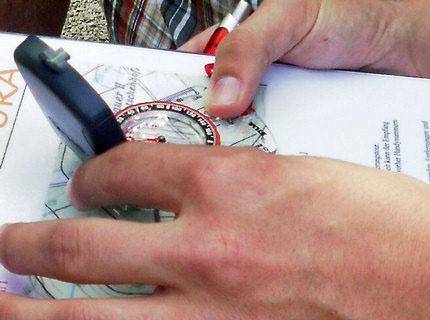source: www.youthwork-practice.com | 2000 Games, Devotions, Themes, Ideas and more for Youth Work
only for private using
Orientation Hike

Orientation Hike like a scavenger hunt | ©: kids.4pictures - Fotolia
"Only together can we reach our goal," is the quintessence, which participants should take home from an orientation hike. They also acquire some practical and social skills that can help them working in a group in the long run. Depending on the educational objective, the youth worker can structure this hike in different ways. In any case, the participants are required to show team spirit, stamina, and skill.
The group leader can use the orientation hike as a means for team building. By now this is commonly practiced by many companies. But you can also make an exciting scavenger hunt or an exciting treasure hunt, in which participants have to solve different puzzles, from the orientation hike. The group will be equipped with a compass, a map and a GPS receiver, which allows them to determine their exact position. The GPS receiver also has a safety aspect: young people can be sent out on their own. However, only if fitted with a mobile phone and GPS receiver. If there is an emergency, the group can alert rescue as well as they are easily located.
Who takes the lead?
The structure within the group should relatively quickly resolve itself without any intervention of the youth worker.
Those participants who are good with the map, compass, and GPS receiver take the lead. However, to provide an adequate experience for all participants they should encounter several obstacles along the way, which only can be solved by working together. For example, there could be a narrow gorge. To get across, together they have to build a bridge, only by the means of available materials.
An alternative is the classic scavenger hunt. In this case, the distance is divided into several stages. The participants are expected by a youth worker, where they have to solve a puzzle or perform a task at the end of each phase. Only then will they learn in which direction the next stage is.

Orientation Hike with map and compass
©: www.youthwork-practice.com
Who is suitable for orientation hikes?
The participants in an orientation hike should be roughly the same age. Otherwise the older participants have an advantage, which potentially causes the younger ones to lose all interest and fun of it. In any case, all participants should be in an age, where they independently can use a map and compass. This is roughly from 5th grade upwards.
An alternative for the younger kids
By the Boy Scouts, it is already common for younger kids to participate in orientation hikes. In this case, the educational objective focuses more on the joint experience of nature as well as learning by doing. Geocaching offers itself as an activity. Usually, the hidden treasures are only to be found in hard accessible places, right in the heart of nature. The participants will not only learn how to deal with compass and map, but also learn a lot about the local flora and fauna.
More informations and ideas concerning outdoor education
- Article: Experience pedagogic | Outdoor education
- Article: Cooperative Adventure Games
- Article: Converting types of games and activities
- Forest games
- Trips with the Sailboat
- Snowshoeing
- Rafting
- Orientation Hike
- Cross-country skiing/ski touring
- via ferrata
- Climbing
- Canoeing
- Kayaking
- En route with a float
- Cycling
- Hiking and mountain tours
- Cave tours
- Rope events
- Canyoneering
- Tree climbing
- Bivvy
[ © www.youthwork-practice.com | 2000 Games and Ideas for Youth Work ]






